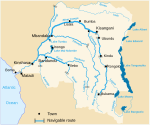Kasai River
| Kasai River | |
|---|---|
 | |
 Kasai River watershed (Interactive map) | |
| Location | |
| Countries | |
| Physical characteristics | |
| Source | |
| • coordinates | 11°34′59″S 19°01′26″E / 11.583°S 19.024°E |
| Mouth | Congo River |
• location | Kwamouth, DRC |
• coordinates | 3°10′55″S 16°11′02″E / 3.182°S 16.184°E |
| Length | 2,153 km (1,338 mi) |
| Basin size | 884,376 km2 (341,459 sq mi)[1] |
| Discharge | |
| • location | Kwamouth (near mouth) |
| • average | 11,500 m3/s (410,000 cu ft/s)[2] |
| Discharge | |
| • location | Lebida |
| • average | 11,318 m3/s (399,700 cu ft/s)[3] |
| Basin features | |
| Tributaries | |
| • left | Fimi |

The Kasai River (
Exploration
Henry Morton Stanley reached the confluence on 9 March 1877, calling the river Nkutu, a "powerful and deep river", but recognizing it as originating from David Livingstone's Kwango.[5]: Vol.Two, 252
Tributaries
The Kasai's main tributaries upstream from the confluence with the Congo:
- Fimi (Fimi-Lukenie length 1100 km, basin size 132 000 km2, mean annual discharge ~ 2000 m3/s)
- Kwilu/Kwango (1800 km, 263 500 km2, 3299 m3/s)
- Loange
- Sankuru (1200 km, 156 000 km2, 2500 m3/s)
- Lulua
Economic importance
The tributaries of River Kasai are clear of obstacles like cataracts and river weed, making them very navigable. They facilitate the transport sector and form an important trade artery. The river's role in transport and trade was more prominent during the pre-colonial period when the slave trade was legal. Slave traders used one of its major tributaries, the Kwango River, to navigate the equatorial rain forest, capture slaves and find their way back to the Atlantic Ocean where they had docked their ships. It is greatly controversial that some of the local kingdoms that were along the Kasai River supported the slave trade. The Rund kingdom for instance, readily provided slaves for the most notorious slave traders like John Matthews, a renowned British slave vendor. These activities, though they occurred between the 18th and 19th centuries, left a lasting impact in the regions where they were most prominent, such as between the Kwango and the Kwilu rivers. The population has never recovered fully, with the population density lower than that of areas that did not experience the slave trade. The most probable trigger to British and Portuguese great interests in the Kasai River was the presence of alluvial diamonds lying in rich deposit beds, especially at the river's mouth. More deposits lie along the beds of a major tributary, the Kwango River. In fact, it is common to hear the phrase “the diamond heartland of North Eastern Angola” used in reference to the Kwango River valley. This is because the diamond alluvial beds found in this region are the richest in Angola.
See also
- Kasai River disaster
References
- .
- .
- .
- ^ ISBN 0585070091.
- ISBN 0486256685
External links
10°57′37″S 19°18′56″E / 10.96028°S 19.31556°E

